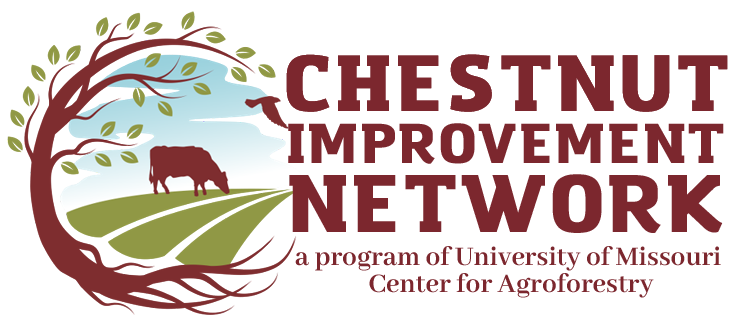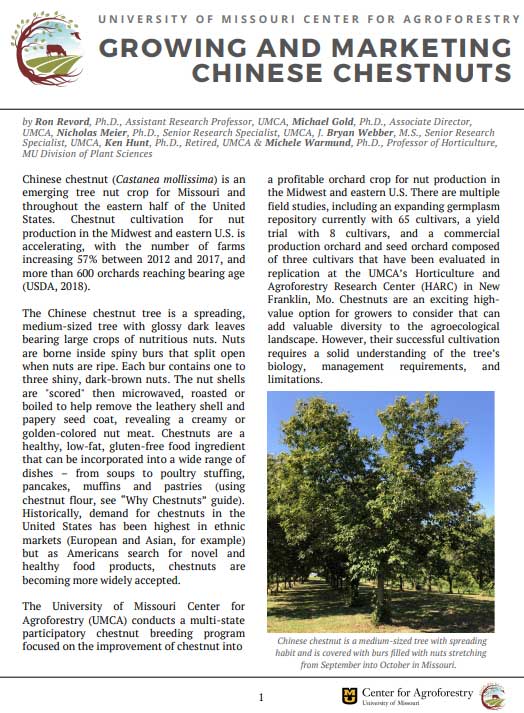Orchard Management
For more information on chestnut orchard management and establishment, check out Growing and Marketing Chinese Chestnuts.

Pruning
To achieve needed tree structure, pruning needs to start in the first year and continue regularly throughout the tree’s life.
- The target initially should be to promote a leader and two main branches. The third year, the aim should be to encourage the tree to spread out. Thinning the inward growing branches is necessary to further encourage branch spreading into the alley.
- By approximately the fifth growing season, commercial cropping should begin. Cut out the central leader in the winter, leaving the two permanent structural branches that reach out into the alleyways to become the tree’s permanent framework. Removing the central leader also reduces tree height. Subsequent tree growth will fill the gaps left by removal of the central leader.
- From this point forward, thin out interior branches as they begin to crowd, and also remove branches to maintain a reduced tree height and elliptical tree shape.
Thinning the orchard
- When seedling or grafted orchards are planted at high density spacings (15 ft x 20 ft or 20 ft x 20 ft), it is likely that thinning will be required as early as age 10. Particularly for seedling orchards since they are faster growing, often growing larger, quicker than grafted trees.
- All participants in CIN will be required to thin trees as soon as (or just prior to) when the tree crowns touch in order to maintain maximum production throughout the life of the orchard. The exact timing of the thinning process will vary based on orchard growth.
- CIN research staff will provide assistance and guidance for selection and culling criteria to assist orchard thinning.
Chestnut Plant Nutrition
Trees should be fertilized with nitrogen annually. However, the optimum nitrogen rate will vary depending on the soil type, orchard floor management, crop load, etc. Soil nitrogen leaches more readily in sandy soils than in heavier types. Thus, nitrogen rates may need to be increased slightly on sandy soils.
- Non-bearing trees should produce 18 to 24 inches of new growth annually. In contrast, bearing trees should produce about 12 to 15 inches of new growth each season.
- To achieve adequate shoot growth, apply 0.1 lb. actual N per tree per year of age.
- For example, for a 3-year-old tree should receive 0.3 lbs. actual N per tree. To calculate the amount of fertilizer product needed, divide the actual N by the percent active ingredient. Thus, if ammonium nitrate (34% active ingredient) is used, then the amount of this product applied per 3-year-old tree would be 0.1 x 3 years ÷ 0.34 = 0.88 lbs. per tree.
- The calculated amount of fertilizer should be split into two applications.
- Two-thirds of the calculated fertilizer amount should be applied before bud swell (April 1)
- The other third should be applied at the end of flowering (June 20).
- Apply the fertilizer within the dripline of the tree. The following growing season, if shoot growth is less or greater than the recommended lengths, nitrogen rates can be adjusted based on the site conditions.
- Sodded orchards may require 20 to 50 percent more N than those where the ground beneath the tree is kept free of vegetation.

Pest Management
- Remove all vegetation and mulch from the tree during winter. Bare soil provides a beautiful backdrop for hawks and owls to spot daring rabbits and voles trying to attack your chestnut trees.
- Raptor poles or owl boxes will promote the establishment of natural predators to rodents keeping the rodent populations in the orchard under control.
- Tree guards around each tree, pressing the guard into the soil can prevent voles and rabbits from digging under them. Once chestnut trees develop rough bark, the threat from rabbits and voles diminishes.
Deer not only browse chestnuts, but bucks also often rub all the bark off trees during late summer and early fall. Deer protection must be put in place when chestnut trees are small and vulnerable to damage.
- Installing a permanent fence around your chestnut planting to prevent deer damage can be cost-effective, as it will protect your trees and crop from year one, on. These fences require regular maintenance.
- Create wire tree cages made of fencing, anchored with stakes for each individual tree. These cages are a cylinder of fencing Trees cages will last for at least the first ten years of an orchard’s life.
- Use specialized 4 to 5 ft tree tubes, that also add sunscald protection. These tubes will need to be removed once the trees are several years old to avoid obstructing tree growth. Tree tubes direct the tree growth upward, promoting vigorous growth and precocity.
- Prompt harvest and good sanitation practices can help keep weevil damage under control.
- Harvested nut should be giving prompt hot water treatment (122 °F for 30 minutes, then immediately cool to ~32 to 34 °F) to kill weevil eggs before they have a chance to hatch.
- In large orchards, control weevil populations by making three applications of carbaryl (Sevin®) at 10-day intervals starting in mid-August. The adult weevils can be scouted and monitored for their presence by jarring the tree and counting fallen weevils.
Adults feed on chestnut foliage until nut kernels enter the dough stage in mid to late August. Although they can lay eggs any time after kernel filling, most eggs are laid after the bur begins to open. The female weevil uses her long proboscis to drill a hole through the shell before turning around and placing her ovipositor into the nut and laying five to seven eggs. Eggs hatch in about 10 days and larval development is completed two to three weeks later. Mature larvae chew a small round hole through the shell, exit the nut, and then burrow into the ground under the chestnut tree. The insect remains in the soil for two to three years before re-emerging as an adult.
Because of their larger size, large chestnut weevils are more successful in laying eggs in nuts before burs open. The long proboscis of large chestnut weevils enables females to drill oviposition sites among the spines of the bur. Eggs hatch in five to seven days producing large, legless grubs. The life cycle of the large chestnut weevil is similar to that of its smaller cousin, but the larger weevil spends only one to two years in the soil.
This curculio is primarily an acorn pest but has been observed to invade chestnut orchards when the acorn crop in nearby forests is low. The nut curculio is related to chestnut weevils and the damage inflicted to chestnut kernels is similar. Curculios have a much shorter proboscis and must wait until the burs open to lay eggs inside the nut. The nut curculio has a one-year life cycle.
- Chestnut gall wasp (Dryocosmus kuriphilus) adults lay eggs in chestnut buds in early summer; larvae remain dormant until buds expand the following spring.
- Gall wasps induce the formation of greenish red, 0.3 and 0.5-inch, leaf and twig galls that suppress shoot elongation, reduce fruiting and cause twig dieback.
- Adult wasps, 1/8-inch long, then begin emerging from the galls during early summer, continuing the cycle. Severe infestations can result in mortality of young trees.
- Parasitic wasps move with chestnut gall wasp populations and have been an important natural biological control to aid in gall wasp population decline.
- At present there are no documented chemical control method(s) in the literature.
- The yellow neck caterpillar (Datana ministra) is an occasional pest of chestnuts.
- These insects feed in large colonies and can completely defoliate a young chestnut tree.
- Scout your orchard regularly starting in late June and look for newly hatching colonies.
- Although this pest is frequently kept under control by beneficial insects, an insecticide can be used to control outbreaks of yellow neck caterpillars. Recommended insecticides include carbaryl and Bacillus thuringiensis.
- Potato leafhopper is a regular pest of many agricultural crops, including chestnut.
- Leafhoppers feed on the veins on the underside of developing leaves causing deformation in May and June.
- Young leaves show cupping and curling and may fall off the tree.
- An orchard spray with carbaryl at the first signs of leaf cupping and curling is recommended.

Chestnut Diseases
- Chestnut blight infects susceptible chestnuts such as the native American chestnut, European chestnut, and other chestnut species, while species such as Chinese chestnut and complex hybrids with a mix of species show a degree of resistance to chestnut blight.
- Chestnut blight causes canker formation and dieback leading to a decline in production and ultimately death of susceptible trees.
- When chestnut blight is found in the canopy of trees, infected limbs may be pruned out to minimize the spread of the infection throughout the orchard.
- The use of fungicides to control chestnut blight is not recommended, resistant chestnut species and pruning/culling highly susceptible individuals are the best forms of control at this time.
- Phytophthora root rot (PRR) is caused by an aggressive and virulent oomycete pathogen called Phytophthora cinnamomi.
- As necrotic tissue expands in the root system it will spread through the vascular system causing leaf wilting in the canopy, stem dieback and potentially mortality.
- Chestnuts should be planted in well-drained, loamy to sandy loam soils.
- Chinese and Japanese chestnuts have a degree of resistance to PRR, and plant breeding efforts are under way to exploit these PRR resistance sources to develop PRR resistant chestnut cultivars and seed sources.
- European and American chestnut species are highly susceptible to PRR and are not recommended to be planted in PRR prone areas.
- Blossom end rot on chestnuts (BER) (also referred to as “Chestnut Anthracnose”) is a nut quality defect where the proximal end of the nut (end nearest the flower) on the outer shell and inner kernel becomes black and rotten.
- Some growers have noted more than 10% of their crop lost to BER in a single season.
- Preliminary reports suggest that there is a significant genetic component involved with BER incidence in an orchard.
- BER incidence is recommended as an important culling criterion to use when thinning a seedling orchard. At present there are no known fungicides or spray methods to control BER infection.
302ABNR Bldg. Columbia, MO 65211





